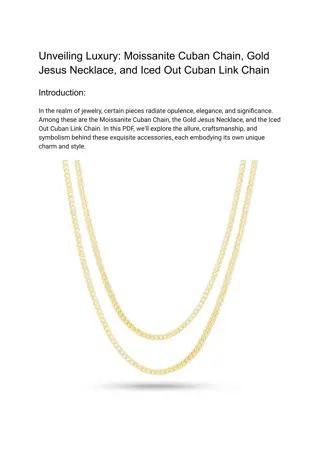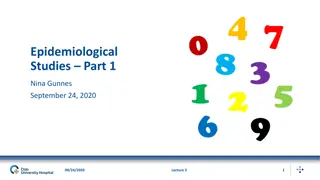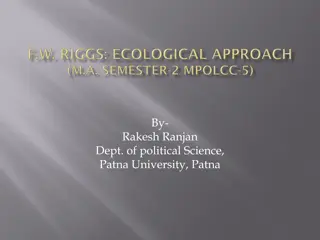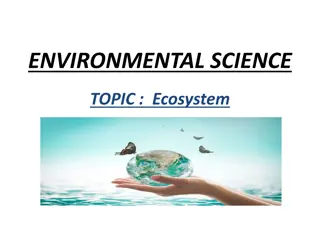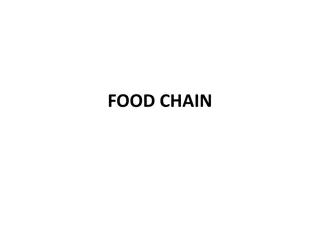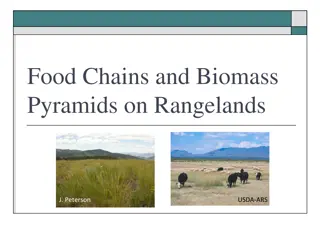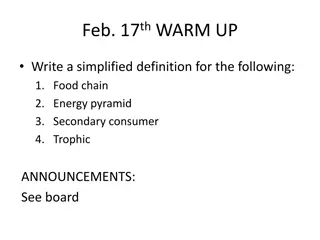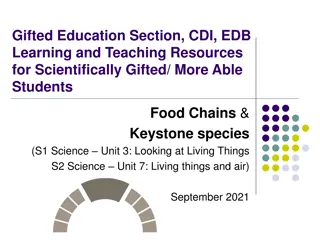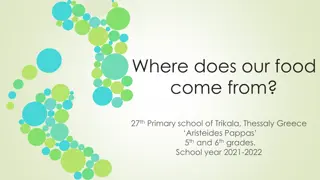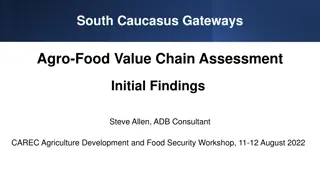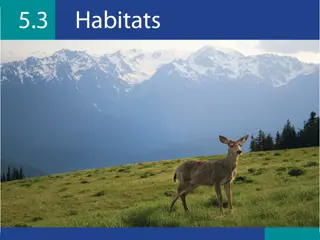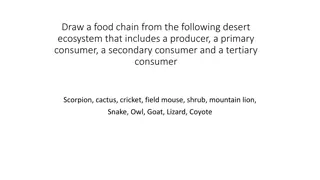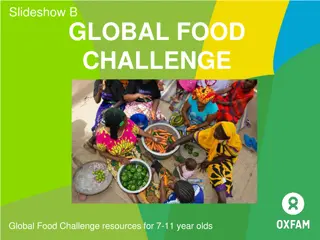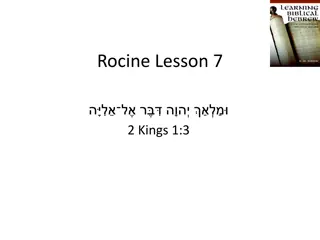Understanding Ecological Relationships and Food Chains
Explore the intricate ecological relationships in nature, including population dynamics, producer-consumer systems, and different types of consumers like herbivores, carnivores, and decomposers. Learn about food chains, food webs, and the interconnectedness of organisms in ecosystems through informative visuals and explanations.
Download Presentation

Please find below an Image/Link to download the presentation.
The content on the website is provided AS IS for your information and personal use only. It may not be sold, licensed, or shared on other websites without obtaining consent from the author. Download presentation by click this link. If you encounter any issues during the download, it is possible that the publisher has removed the file from their server.
E N D
Presentation Transcript
Ecological Relationships
Ecological Relationships Population Dynamics: the pattern of any process or interrelationship that affects growth or change in a population. Producers-consumer systems Predator/prey relationships Parasite/host relationships Organism Competition
What is a Producer? An organism capable of producing organic compounds from inorganic molecules through the process of photosynthesis or chemosynthesis. It is also called an autotroph. -The first level of a food chain Examples:
What is a Consumer? An organism that obtains food by feeding on other organisms or organic matter. It is also called a heterotroph - All other levels of a food chain Examples:
There are different kinds of consumers: Herbivores organisms that eat plants and other organisms that photosynthesize Carnivores organisms that eat other animals Omnivore an organism that eats both plant and animal matter Decomposers organisms that eat and recycle dead animal and plant matter and release chemical nutrients back into the environment Which picture is a herbivore? Carnivore? Decomposer?
What is a Food Chain? A sequence of who eats whom in an ecosystem. -food chains begin with an autotroph -the second level of a food chain is called a primary consumer -the succeeding levels are called secondary consumer, tertiary consumer, etc. until the end of the chain
What is a Food Web? Animals often have more than one source of food the food chain is just one option of what they can eat. Food webs show how different organisms are interconnected by different paths Food webs are made up of food chains
Food Web Example of a food web: What are the producers? What are the primary consumers? What are the secondary consumers? Are there any tertiary consumers?
Food Webs in Different Ecosystems What are some different types of ecosystems? Terrestrial (prairies, forests, mountains, etc) Aquatic Freshwater (ponds, rivers, lakes) Marine (oceans, saltwater marshes) Let s look at some food webs for these ecosystems in Texas
Terrestrial What are the producers? What are the consumers? Are there carnivores? Herbivores? Omnivores? What kind of ecosystem might this food chain be from?
Aquatic - Freshwater What are the producers? Consumers? How many different consumer levels are there?
Aquatic - Marine What are the producers in this food web? Who are the predatory consumers? The herbivory consumers?
Some consumers are also called predators. Predators are animals who eat other animals, called prey. Another word for predator is carnivore. Which of the following are predators?
Some animals eat BOTH plants and animals: These animals are called omnivores The sparrow is an omnivore! They can eat seeds, grains, and bugs! What are other omnivores? Humans!
Predator-Prey Systems Both predator and prey populations affect the survival of the other. The bobcat is a predatory cat in the U.S. The bobcat s favorite food (prey) is a snowshoe hare. Let s look at how populations of bobcats and hares interact over time.
Population Changes in Bobcats and Hares 70 60 50 40 Snowshoe Hare Bobcat 30 20 10 0 April May June July
Observations What happened to the snowshoe hare population in April, May, and June? What happened to the bobcat population in April, May, and June? What happened to the snowshoe hare population in July? What happened to the bobcat population in July? What do you think will happen to the populations in August, September, October, and November?
Population Changes in Bobcats and Hares 80 70 60 50 Snowshoe Hare Bobcat 40 30 20 10 0 August September October November
Observations What happened to the populations in the later months? Did the population numbers of the predators affect the numbers of prey? Did the numbers of prey affect the numbers of predators?
Predator-prey Relationships Predator-prey systems generally work in constantly-changing cycles much like the one we just saw with the bobcats and hares. As the prey population increases, there is more food for the predators, so predators increase. When the predators increase, there are more of them to eat the prey, until the prey species begins to decline under the predatory stress When the prey declines, there is not as much food for the predators, so the predatory species declines until the prey population recovers and the cycle begins again.
In biology, the term parasite refers to an organism that grows, feeds and is sheltered on or in a different organism while contributing nothing to the survival of that organism. The organism where the parasite takes residence is called a host.
Hosts Serve as a physical location or microenvironment that provides place for habitat, growth factors, nutrients supply to parasites Help in the multiplication of parasites Plants or animals can be hosts:
Parasites Metabolically dependent on the host for its survival Smaller than host size Sometimes harmful to the host Parasites can be animals, plants, bacteria, fungi, protozoa, or viruses:
Kinds of Parasites and Hosts Ectoparasite parasite found outside the host surface Endoparasite parasite found inside the host or inside the host cells Final host - host on which parasites sexually reproduce Intermediate host - Hosts that are not continuous and are temporary Transfer host - Tool for reaching final host and it is not involved in completion of life cycle Reservoir host A host that is endangered or infected by parasites
Parasite Examples Ectoparasites Endoparasites
What is a habitat? The natural environment of an organism Scientific name for an organism s home A habitat must have all things that are essential for an organism s survival: Food Water Shelter/cover Space Resources
Resources Food Nutrients consumed by an organism for energy Water All life on Earth requires water Shelter/cover Humans can consider shelter to be a house; or a structure they live in. An animal s shelter may be underground, in a bush, in the bark on a tree, or in some rocks, etc. Space Organisms need enough space in which to live and find the food/water/shelter
Competition Much of the time, there are not enough resources to go around. As a result in scarcity of resources, there is competition between organisms in their environment. Competition between animals Competition between plants
Animal Competition Resources that animals mainly compete for are: Food Water Shelter Space Access to mates What are these animals competing for?
Plant Competition Resources that plants compete for are: Water Nutrients (food) Space (access to light, water or nutrients) What do you think these plants are competing for?
Competition When different species compete for resources, it is called inter- species competition When organisms of the same species compete for resources, it is called intra-species competition Inter-species competition Intra-species competition
Competition Tying It All Together Do predators (carnivores) compete for resources? Do herbivores compete for resources? Do producers compete for resources?


